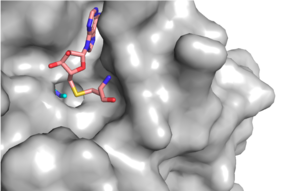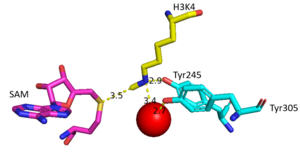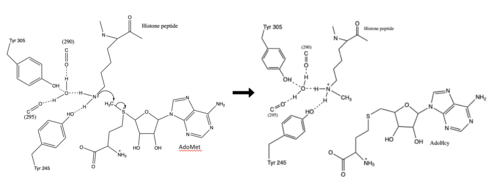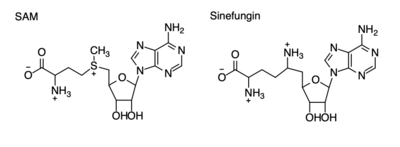User:Ashley Crotteau/Sandbox1
From Proteopedia
| Line 1: | Line 1: | ||
=''H. sapiens'' Lysine Methyltransferase, SET 7/9= | =''H. sapiens'' Lysine Methyltransferase, SET 7/9= | ||
| - | |||
| - | <StructureSection load='1O9S' size='350' frame='true' side='right' caption='H. sapiens KMT 1o9s' 'scene=81/811707/Kmt_active_site/1'> | ||
==Introduction== | ==Introduction== | ||
Revision as of 15:13, 12 April 2019
Contents |
H. sapiens Lysine Methyltransferase, SET 7/9
Introduction
Structure
SET Domain
The (HKMT) SET7/9 is 366 amino acids long. The overall structure looks like a dimer although it acts as a monomer. The structure is composed of the ΔSET7/9 domain. The ΔSET7/9 consists of the SET domain along with the pre- and post-SET regions.[1][2] The pre- and post-SET regions are adjacent to SET domain and are cysteine rich.[1][2] The pre-SET cysteine region is located near the N-terminal where the post-SET region is located near the C-terminal of the domain.[1][2] These regions are said to play an important role in substrate recognition and enzymatic activity.[1][2]
The SET domain is mostly defined by with the few .[1] form a β-hairpin that sticks out at a right angle to the surface of the enzyme.[3] The following three residues () accommodate a sharp bend in the peptide chain and the end of the protein adopts an .[3] The two most defining features of the SET domain are the C-terminal tyrosine and the knot-like fold. These two components have been recognized to be essential for (SAM) binding and catalysis.[1] [2] [4] The knot-like fold contains the binding sites for the cofactor SAM and the peptide substrate.[5]
Active Site and Channel
The most notable feature of the HKMT is the presence of the lysine access channel as the active site. The cofactor and substrate are actually located on opposite sides of the SET domain but are connected through this narrow channel (Figure 1).[3] This channel allows these two components to interact and complete the methyltransfer. The active site in general is considerably tyrosine rich. Residues Tyr245, His297, Ser268, Tyr305, Tyr335, and Tyr337 all help to shape the and the channel.[3] The cofactor involved, SAM, provides the methyl for methylation of the lysine on its sulfur atom.
The beta hairpin stabilizes the , while also shaping one side of the channel which the peptide binds to.[3] The is composed of residues 255-268.[3] Lysine would have trouble coming down into the active site in its charged form, but it is facilitated by the faces of the flanking tyrosines.[3] The orientation of the lysine is such that the amine-methyl bond is aligned towards the sulfur on SAM so that it can provide the methyl. There is an important water in the active site (Figure 2) as well that acts as a stabilizer for lysine, and helps to shift the lone pair on the nitrogen towards the sulfur of SAM. [3]
Function
The conserved regions of KMT has been found to be vital for function. Multiple studies have found that a mutation to any of the conserved tyrosine residues continues to monomethylate SAM, while it also creates di-methylation and tri- methylation of SAM.[6] In a recent study, Y245A and Y305F were created through site-directed mutagenesis.[6] Due to size, Ala245 was found to create a larger opening of the channel than tyrosine, which allowed for further methylation of SAM. [6] However, Y305F also showed the same characteristics of di- and tri-methylation, most likely due to a decrease of tyrosine residue interaction with water.[6] As there are four invariant conserved tyrosine residues (Tyr305, Tyr245, Tyr335, Tyr337) in the active site, this finding indicates that the function of KMT is dependent on the presence of tyrosine residues in the active site. [6]
Relevance
Renal Fibrosis
The inhibition of KMT SET 7/9 has been found to enhance renal fibrosis.[7] H3K4 methylation activates the transcription of fibrotic genes, and the suppression of the H3K4 methylation was found to enhance renal fibrosis in a mouse model.[7] Sinefungin, a competitive methyltransferase inhibitor, binds to KMT to inhibit SAM.[7] SAM and Sinefungin have similar structures (Figure 4), differing only with the removal of a sulfide and the replacement of a methyl to an amine. The amine replaces the methyl donor for the reaction of KMT, inhibiting the reaction and preventing methylation. Without the methylation of H3K4, the transcription of fibrotic genes is deactivated, leading to renal fibrosis.[7]
Cancer
Many studies have shown that lysine methyltransferases lead to the inhibition of cancers, therefore they are being studied as possible cancer therapy treatments. Lysine methylation contributes to the inactivation of a tumor suppressor gene. Due to this, KMTs are being studied as possible biomarkers for the detection of cancers. Inhibitors of KMT, such as Sinefungin (Figure 4), were used in a study to observe KMT’s effect on cancerous cells. It was found that when KMT is deregulated, tumor behavior increases due to a lack of methylation, indicating the importance of the histone methylation. [8]
</StructureSection>
References
[3] [5] [1] [2] [4] [6] [7] [8]
- ↑ 1.0 1.1 1.2 1.3 1.4 1.5 1.6 Schubert HL, Blumenthal RM, Cheng X. Many paths to methyltransfer: a chronicle of convergence. Trends Biochem Sci. 2003 Jun;28(6):329-35. PMID:12826405
- ↑ 2.0 2.1 2.2 2.3 2.4 2.5 Yeates TO. Structures of SET domain proteins: protein lysine methyltransferases make their mark. Cell. 2002 Oct 4;111(1):5-7. PMID:12372294
- ↑ 3.0 3.1 3.2 3.3 3.4 3.5 3.6 3.7 3.8 Xiao B, Jing C, Wilson JR, Walker PA, Vasisht N, Kelly G, Howell S, Taylor IA, Blackburn GM, Gamblin SJ. Structure and catalytic mechanism of the human histone methyltransferase SET7/9. Nature. 2003 Feb 6;421(6923):652-6. Epub 2003 Jan 22. PMID:12540855 doi:10.1038/nature01378
- ↑ 4.0 4.1 Huang S, Shao G, Liu L. The PR domain of the Rb-binding zinc finger protein RIZ1 is a protein binding interface and is related to the SET domain functioning in chromatin-mediated gene expression. J Biol Chem. 1998 Jun 26;273(26):15933-9. PMID:9632640
- ↑ 5.0 5.1 doi: https://dx.doi.org/10.1016/C2014-0-02189-2
- ↑ 6.0 6.1 6.2 6.3 6.4 6.5 Del Rizzo PA, Couture JF, Dirk LM, Strunk BS, Roiko MS, Brunzelle JS, Houtz RL, Trievel RC. SET7/9 catalytic mutants reveal the role of active site water molecules in lysine multiple methylation. J Biol Chem. 2010 Oct 8;285(41):31849-58. Epub 2010 Aug 1. PMID:20675860 doi:http://dx.doi.org/10.1074/jbc.M110.114587
- ↑ 7.0 7.1 7.2 7.3 7.4 Sun G, Reddy MA, Yuan H, Lanting L, Kato M, Natarajan R. Epigenetic histone methylation modulates fibrotic gene expression. J Am Soc Nephrol. 2010 Dec;21(12):2069-80. doi: 10.1681/ASN.2010060633. Epub 2010, Oct 7. PMID:20930066 doi:http://dx.doi.org/10.1681/ASN.2010060633
- ↑ 8.0 8.1 Tian X, Zhang S, Liu HM, Zhang YB, Blair CA, Mercola D, Sassone-Corsi P, Zi X. Histone lysine-specific methyltransferases and demethylases in carcinogenesis: new targets for cancer therapy and prevention. Curr Cancer Drug Targets. 2013 Jun;13(5):558-79. doi:, 10.2174/1568009611313050007. PMID:23713993 doi:http://dx.doi.org/10.2174/1568009611313050007
Student Contributors
Ashley Crotteau
Parker Hiday
Lauren Allman




